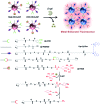An enzyme-responsive metal-enhanced near-infrared fluorescence sensor based on functionalized gold nanoparticles
- PMID: 29142724
- PMCID: PMC5664366
- DOI: 10.1039/c5sc01850a
An enzyme-responsive metal-enhanced near-infrared fluorescence sensor based on functionalized gold nanoparticles
Abstract
Near-infrared (NIR) fluorescence imaging is promising due to the high penetration depths and minimal levels of autofluorescence in living systems. However, it suffers from low fluorescent quantum yield, and metal-enhanced fluorescence (MEF) is considered to be a promising technique to overcome this. Stimuli-responsive NIR fluorescence enhancement shows remarkable potential for applications in medical imaging and diagnosis. Herein, we successfully fabricated an enzyme-responsive near-infrared sensor based on MEF by functionalizing gold nanoparticles with NIR fluorophores and enzyme-responsive self-aggregation moieties. The NIR fluorescence of fluorophores on the gold nanoparticles was significantly enhanced due to increases both in the light scattering intensity and in the radiative decay rate (kr) of the NIR fluorophores, along with relatively small variation in the nonradiative decay rate. This novel strategy for NIR fluorescent sensors should be particularly promising for NIR fluorescence imaging of enzyme activities and early diagnosis based on rationally designed nanomaterials.
Figures





Similar articles
-
Multifunctional Thio-Stabilized Gold Nanoparticles for Near-Infrared Fluorescence Detection and Imaging of Activated Caspase-3.Curr Anal Chem. 2021;17(8):1182-1193. doi: 10.2174/1573411017999210112175743. Curr Anal Chem. 2021. PMID: 34393690 Free PMC article.
-
Tunable Three-Dimensional Plasmonic Arrays for Large Near-Infrared Fluorescence Enhancement.ACS Appl Mater Interfaces. 2019 Jul 3;11(26):23083-23092. doi: 10.1021/acsami.9b08802. Epub 2019 Jun 19. ACS Appl Mater Interfaces. 2019. PMID: 31252484
-
A Unique "Integration" Strategy for the Rational Design of Optically Tunable Near-Infrared Fluorophores.Acc Chem Res. 2017 Jun 20;50(6):1410-1422. doi: 10.1021/acs.accounts.7b00087. Epub 2017 May 11. Acc Chem Res. 2017. PMID: 28492303
-
Recent Progress in Fluorescence Imaging of the Near-Infrared II Window.Chembiochem. 2018 Dec 18;19(24):2522-2541. doi: 10.1002/cbic.201800466. Epub 2018 Nov 9. Chembiochem. 2018. PMID: 30247795 Review.
-
Recent Advances in Second Near-Infrared Region (NIR-II) Fluorophores and Biomedical Applications.Front Chem. 2021 Oct 18;9:750404. doi: 10.3389/fchem.2021.750404. eCollection 2021. Front Chem. 2021. PMID: 34733821 Free PMC article. Review.
Cited by
-
Stimuli-Responsive Plasmonic Assemblies and Their Biomedical Applications.Nano Today. 2021 Feb;36:101014. doi: 10.1016/j.nantod.2020.101014. Epub 2020 Nov 8. Nano Today. 2021. PMID: 33250931 Free PMC article.
-
Metal-enhanced fluorometric formaldehyde assay based on the use of in-situ grown silver nanoparticles on silica-encapsulated carbon dots.Mikrochim Acta. 2020 Jan 17;187(2):137. doi: 10.1007/s00604-019-4105-2. Mikrochim Acta. 2020. PMID: 31953688
-
Resonance plasmonic coupling: selective enhancement of band edge emission over trap state emission of CdSe quantum dots.Chem Sci. 2024 Nov 11;15(48):20263-20273. doi: 10.1039/d4sc04960h. eCollection 2024 Dec 11. Chem Sci. 2024. PMID: 39568884 Free PMC article.
-
Guarding food safety with conventional and up-conversion near-infrared fluorescent sensors.J Adv Res. 2022 Nov;41:129-144. doi: 10.1016/j.jare.2022.01.011. Epub 2022 Jan 30. J Adv Res. 2022. PMID: 36328742 Free PMC article. Review.
-
In Situ Generated Novel 1H MRI Reporter for β-Galactosidase Activity Detection and Visualization in Living Tumor Cells.Front Chem. 2021 Jul 15;9:709581. doi: 10.3389/fchem.2021.709581. eCollection 2021. Front Chem. 2021. PMID: 34336792 Free PMC article.
References
-
- Ntziachristos V., Ripoll J., Weissleder R. Opt. Lett. 2002;27:1652. - PubMed
-
- Weissleder R. Nat. Biotechnol. 2001;19:316–317. - PubMed
-
- Rangioni J. V. Curr. Opin. Chem. Biol. 2003;7:626–634. - PubMed
-
- Ballou B., Ernst L. A., Waggoner A. S. Curr. Med. Chem. 2005;12:795–805. - PubMed
-
- Licha K. Top. Curr. Chem. 2002;222:1–29.
LinkOut - more resources
Full Text Sources
Other Literature Sources
Miscellaneous

